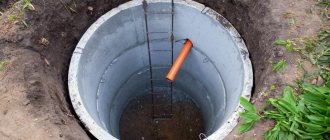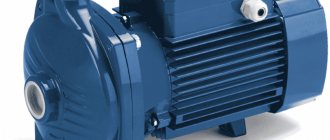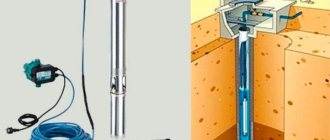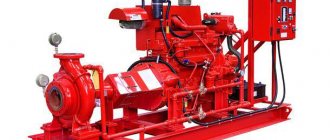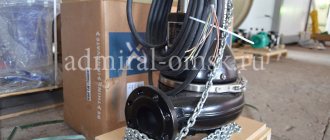The design of a manual hydraulic pump and its operating principle
The simplest to set up and operate is a manual hydraulic pump.
- The design of a manual hydraulic pump and its operating principle
- Design and diagram of a manual hydraulic pump
- How to choose the right hydraulic manual pump?
- Manual hydraulic pumps NRG
- Pros and cons of hydraulic hand pumps
- Types of manual equipment for pumping water
- Why is a hand pump necessary in the country?
- About water supply and its pressure
- Sources:
It is based on the principle of fluid displacement. In industry, such units are quite in demand; their main function is pumping fuels and lubricants.
General information
To understand the principle of operation of the pump and why it is designed this way and not otherwise, you first need to define what an autonomous water supply is. This is a complex system with different effects depending on the type of product. It consists of many elements and provides water under pressure. The key element of this system is the pump, of which there are countless varieties. There is submersible and surface. The predominant manufacturers are:
- China;
- Russia;
- European countries.
But effective operation is ensured only if the equipment is complete with a battery and automation.
The pump sucks water from a source, for example, a well, collects it in a special container, and then delivers it under pressure to the consumer. The main difference between the pumps is in the characteristics and dimensional data. It is important to choose this equipment correctly so that the water supply is ensured at the proper level.
Scope of application of a mechanical pump and its advantages
The most budget-friendly way to provide water to country houses and plots is to drill a shallow Abyssinian well (you can do it yourself) and use a mechanical unit to pump out liquid from the depths. Any manual pump can be used to lift liquid from various water sources, while performing the following work:
- water supply for living people, the reservoir is a well or a shallow well;
- abstraction of clean or contaminated water from reservoirs for irrigation and domestic purposes;
- drainage in rooms located below the surface of the earth; using a pump, you can pump out liquid that collects in pits under the floor;
- pumping out water from flooded cellars, storage facilities, underground garages, caisson pits.
The use of mechanical pumps has the following advantages compared to electric models:
- Low cost, significantly different from electric pumps.
- Economical - no electricity is required to operate, and little physical effort always brings health benefits.
- A simple device makes it easy to repair the units; some craftsmen even assemble a hand pump for a well with their own hands.
- The maintainability of mechanical pumps is much higher than that of electric pumps - damaged parts can not only be purchased in a retail chain, but can also be manufactured independently.
Rice. 2 Features of landing a manual water supply installation on a well pipe
- The installation method allows you to independently install hand pumps for wells and wells in a water source without the involvement of qualified specialists and special equipment.
- A hand pump for a well can be placed not only on your own property, but also in public places - due to its low cost and difficulty in dismantling, its safety is much higher than that of expensive electric analogues.
- The pump, placed in a cast iron or metal case, is not afraid of external temperature influences and moisture, and, unlike electric pumps, does not require special canopies to protect it from precipitation.
Scope of application of manual submersible pump
Hand pumps are optimal for areas with unstable power supply
The main purpose of operating pump-type units is to pump water from the depths to specific points, for example, a garden, a house, a garage, a bathhouse, etc.
All private houses are divided into three large groups: periodic, seasonal and permanent residence. Not all of them have electricity, and some are supplied, but not on a permanent basis.
Summarizing the above factors, the following conclusions follow:
- In houses intended for permanent residence, there is always electricity, so it is preferable to install electric pumps to supply water. The manual model is only an auxiliary device.
- If we are talking about seasonal buildings where power lines are not connected, installing a hand pump is the best option.
You can draw water from containers with buckets, but a pumping station, even manual, is more convenient.
Feasibility of application
Hand pumps for pumping water do not require electrical power or the use of any other energy carrier, which is one of their most significant advantages. Manual water pumps can be used as backup equipment and used in cases where the main electrical device is unable to function due to a breakdown or lack of voltage in the power supply.
An advisable solution is to install a hand pump in summer cottages that the owners rarely visit, only from time to time.
In such cases, it is undesirable to use more expensive electric pumping equipment, which requires regular maintenance and more thorough care. In addition, an electric pump left unattended by its owners for a long time can simply be stolen.
Hand pumps for water are actively used in dachas and country houses that do not yet have a central power supply. In such cases, the use of a manual device for pumping liquids will allow you to obtain the required amount of water both for domestic needs and for watering garden and vegetable plants in the summer.
Control option
Automatic models can be used over a long period of time without intervention from the user. They have many sensors:
- pressure;
- dry running;
- short circuit protection.
If there is a threat of a short circuit, clogging or any other problem that could lead to equipment failure, the control circuit turns off the pump.
Manual type models are used in a completely different way. Their structure also differs from other species. Repairs to such a unit are required much more often. Therefore, automatic control is more suitable for domestic use. It may cost more, but over time this choice pays off.
Types of pumps, their operating principle and design
If the liquid surface is located at a shallow depth and there is no need to purchase expensive electric analogues, you should pay attention to mechanical pumping stations.
Well pumps differ in their design principles.
- Membrane units are used for pumping not only clean, but also dirty liquids. Mechanisms do not jam due to the self-cleaning valve. The design contains no rubbing parts that could wear out quickly. This has a good effect on work duration and productivity. The liquid suction height is no more than 6 meters.
- Vane - self-priming structures (up to 1 meter), which consist of several valves, a body, a shaft, a wing, a suction element and a lever. Designed for pumping liquids free of solid particles, edible oils, alcohol and liquid fuels. On the Russian market, the cost starts from 4000-5000 rubles.
- Rod pumps are capable of lifting liquid from depths of up to 30 meters. They have a similar design and piston ones. The only difference is the more elongated shape of the piston. The disadvantages of the unit are bulkiness, as well as the likelihood of the rod breaking.
- Piston pumping stations create outlet pressure. The housings are usually made of stainless steel, and other parts are made of fluoroplastic. They will not be able to pump water from deep wells, but they can easily replace surface electric pumps.
Hydraulic pumping stations have become famous due to their compact size. The weight of the structure is only 4 kg.
Shaft connection type
There are 2 ways to transfer rotation from the motor to the pump: through a coupling or directly .
If the pump and motor are two separate machines, then they must be connected by a coupling.
Coupling connection
Couplings come in different shapes, sizes and designs. And one common requirement for them is to ensure the correct integrity of the shafts, otherwise without them, ensuring integrity would be a very sophisticated process.
To facilitate and maintain integrity, the engine and pump are mounted on a common support - a base plate.
Or, in the case of vertical installations, the engine is located on the frame.
This type of connection between the motor and the pump is called coupling. For large powerful installations and pumps with a dismountable casing, connection via a coupling is the only possible option.
The second connection method is direct. The engine and pump are located on a common shaft with a wheel located in a cantilever on the other side of the engine shaft. In this case, the installation does not require a coupling or complex procedures to maintain integrity.
However, because the motor and pump are located on the same shaft, supported only by the motor bearings, this method is only suitable for small and medium-sized end suction pumps.
Working principle of a manual hydraulic pump
Before starting to work with any pump, be sure to inspect the tool and if cracks and chips are found on the surface, do not use it. It is important to check whether the high pressure hose is tightly connected to the hand pump.
Work algorithm:
- We connect the pump to the hydraulic system with a quick-release coupling;
- Turn the valve all the way clockwise.
- Using progressive movements, pump the pump handle up and down. As a result, oil is pumped into the system from the pump. At the same time, pressure builds up in the system, and the piston of the hydraulic tool moves, into which we pump oil.
- In a situation where the working piston of the system into which oil is poured reaches its final position, increased pressure will be created in the system, as a result it will be impossible to pump oil. Then it is necessary to stop the pump to avoid failure of the device.
- In order to lower the pressure in the system, you need to slowly turn the valve all the way counterclockwise. As a result, oil from the system will flow back into the pump. This occurs due to the return of the piston to its original position.
- After finishing pumping oil, you should inspect the hydraulic system for oil leaks, and you should also inspect the pump. If leaks are found, they should be corrected immediately.
How to choose the right hand pump for water
When choosing water pumps for a summer house or a private home or making a manual water pump yourself, you should focus on a number of parameters of both the device itself and the source from which the liquid medium will be pumped. Such parameters, in particular, include:
- the depth of the aquifer (the pressure that a hand pump for water from a well must provide depends on it);
- the diameter of the casing in the well, if it is planned to install sucker-rod pumping equipment;
- equipment performance;
- the degree of contamination of the liquid medium, which influences what type of hand pump for water from a well can be used;
- ergonomics of the device.
As for the service life of hand pumps, it is obvious that a stainless steel pump will be the most durable
Having assessed all of the above parameters, you can decide which manual pumping device is best for you: a piston-type garden water pump, a rod pump, a diaphragm pump or a vane pump.
How to independently diagnose problems and fix them?
This section describes the most common pump performance problems and how to correct them.
When does cavitation occur and how to get rid of it?
- The ventilation pipe is clogged or its diameter is too small. In this case, it is worth cleaning or buying a wider pipe and replacing it.
- Air or gas particles have entered the liquid. In case of this problem, it is necessary to completely immerse the pump in water or install special fender flaps.
- The pipeline is clogged or slagged. To fix the problem, you need to clean it and the hydraulic section.
- Excessively high pumping temperature - find another pump.
What is the reason for the lack of power?
- The pump is rotating in the wrong direction. In this case, it is necessary to swap the phases.
Attention! This only applies to three-phase pumps.
- Wheel wear or damage. It is necessary to replace a broken or unusable part.
- If the pump line or wheel is clogged, then you need to clean them;
- The check valve is clogged - just filter it;
- The valve may be leaking. Then you need to close it tightly.
- The ventilation is clogged. Inspect and clean if necessary.
In what cases does the control device indicate Overload?
- The mains voltage has dropped. In this case, check the voltage.
- High fluid density overworks the motor. It is necessary to change the motor or install a smaller wheel.
- Increase in device temperature. If this happens, then it is immediately necessary to reduce the generation using shut-off valves.
- If one phase has failed, then you need to check the contacts and change the fuses if necessary.
Why does the check valve make noise and how to deal with it?
There can be one reason for this - the valve closes very slowly and can hit. In this case, it is necessary to change it to a quick-closing one.
If the equipment itself is loud, how can you solve the noise nuisance?
- Inappropriate wheel alignment. In this case, we change the cable's power cores.
- Damage to the impeller. The solution would be to change the spare part.
- The machine or ventilation line is clogged. In case of any contamination, we clean it.
- Low liquid level in the tank. Then we check the level and, if necessary, reconfigure the device.
- The noise may be caused by swaying pipelines. We check the elasticity of the connections and secure them tightly using pipe anchors.
Conclusion: this section was created to control the correct operation of water pumps. If you take proper care of it and can fix it yourself, and at the first signal, breakdowns, your pumps will serve you efficiently and reliably for decades.
Pros and cons of hydraulic hand pumps
Pros:
- Easy to use;
- Do not require any additional energy source;
- High maintainability;
- Have high mobility;
Minuses:
- Low performance;
- Muscular strength of the operator is needed, therefore, additional load on the operator;
Bottom line, it is reasonable to use a manual hydraulic pump in small workshops and mobile services, where there is no need to pump in large volumes of oil and build up significant pressure. In general, hand pumps are very convenient, and most importantly, they are mobile since they do not depend on any energy sources.
Installation of a manual water pump for wells and wells
There should be no difficulties in installing a manual water pump; the procedure is simple and does not require any special skills.
To install a manual pumping station, you need to perform the following algorithm:
- Check the package, all supplied parts must be in place.
- The pump housing is installed in a vertical position so that the lower part is immersed in water.
- If the supplied instruction manual states that the device is not intended for pumping water with a high content of solid impurities, additional cleaning filters must be installed.
- The structure must be secured to the surface of the earth in such a way that it stands strong and stable.
- Pump the pump so that the inside is flushed with plenty of clean water.
It is recommended to choose the area for installation as flat as possible; first remove stones and other debris.
Operating rules
Despite the practicality and durability of mechanical pumping equipment, adhere to the basic rules of installation and operation. It is recommended that installation and connection be carried out by specialists, otherwise ensure that:
- all node connections are in place and fixed in accordance with the manufacturer’s instructions, the control valve is tightly closed;
- the pump is securely fixed to the surface - for this purpose concreting or anchoring is used;
- pumping out water is carried out by applying a reciprocating movement within the amplitude provided by the handle.
In order for the pump to serve you for many years, try not to use it to the limit of its capabilities, prevent the risks of mechanical damage to the housing or piston/rod system, and periodically disassemble the station in order to diagnose the condition of the node connections.
Consumer Reviews
To select a suitable pump, you need to know well the conditions of its use and the characteristics of the model. But it doesn’t hurt to study what consumers think about them. The problem is that all manufacturers praise their products, but not everyone can boast of good reviews. Many people have bitter experiences with the chosen product. They can share it completely free of charge.
It is not worth buying equipment from a Chinese manufacturer, because the quality leaves much to be desired. This is the opinion of users. But buyers report that there will be no difficulties with equipment from Vilo, the main supplier from Europe. And SAER pumps are repaired in service centers for a long time and often. It is better to look for a middle ground when good price and quality are combined.
Types of manual equipment for pumping water
- Piston.
- Stock
- Winged.
- Membrane.
Piston
The design is based on a cylinder with a piston, inside the piston there is a piston valve. The second valve, a disc valve, is located at the bottom of the cylinder.
Operating principle
The piston rises, the lever moves in the opposite direction, and there is an airless space in the pipe, which is ideal for lifting liquid. A vacuum is created, lifting the water up into the cylinder. The disc valve is activated and fluid is allowed to enter the cylinder. When the lever is raised, the piston begins to move down. In this case, the bottom valve closes and the liquid gets access above the cylinder. When the lever is lowered again, the water drains into the pipe, which is located in the upper part of the cylinder.
Piston hand pumps can lift water 4-4.5 meters. It is possible to achieve a higher value if the flange connections are characterized by increased tightness and there is a check valve.
Scope of application: pumping water from a well or well, the depth of which does not exceed 7 meters.
Rod
The cylinder is long, which makes it possible to lift liquid from deep layers.
The rod is made up of two rods connected to each other by a hinge.
Scope of application: for pumping water from wells and wells more than 7 meters deep.
Winged
Self-priming equipment. At the outlet a pressure of 2 atmospheres is created.
The design consists of a body, a special wing with four valves, a lever, a shaft with a seal, a suction part, and a cover.
Operating principle
The wings carry out rotational movements under the influence of the lever, which ensures the suction and release of the water flow. In this case, the water flow is characterized by continuity.
Scope of application: pumping water from wells and wells, the depth of which does not exceed 9 meters. In addition, these hand pumps can be used to pump salty liquids, since the body elements are made of bronze.
Grundfos models
It is unlikely that there is a person who has not heard of the products of this company. Now it is the most widespread and largest manufacturer of such equipment, which supplies submersible, vortex, circulation, drainage and vibration models. The buyer, in turn, gets a large selection and can choose any pump depending on his needs.
All equipment from this manufacturer is equipped with many sensors to protect against breakdowns. The range includes pumps of all types of power - both low power for wells and more powerful ones for mine wells. Models are of good quality, from parts to assembly itself.
About water supply and its pressure
One of the key characteristics of the pump is the water flow rate. It is necessary to calculate how many cubic meters of water the home owner spends per hour to find out which option is suitable.
Another important characteristic is pressure. It indicates with what force the unit will supply water. This parameter is calculated according to how far the water source is from the house. The pressure is lost under the influence of height and forks in the pipeline, so it is better to provide a small margin when calculating.
